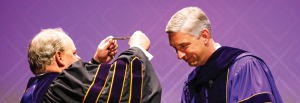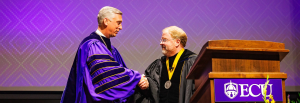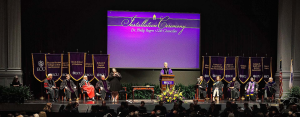
Philip Gregory Rogers (1983-) was installed as ECU’s eleventh chancellor and East Carolina’s sixteenth chief executive officer (including interims), on March 24, 2022, in Wright Auditorium, just two years after the COVID-19 pandemic approached crisis levels. At ECU, the pandemic brought a shift to distance education, with virtual meetings becoming the order of the day. By the spring of 2022, as mask requirements were being lifted faculty and students were encouraged to return to the classroom, but COVID precautions still prevailed, especially among vulnerable populations.
Attendance at Rogers’ installation was lower than any ever before, no doubt due to COVID. Overall, inaugural week was planned along modest lines, with emphasis on outdoor, open space events rather than indoor concerts, stage performances, or exhibits. The academic procession into Wright was unique, with many donning academic regalia plus face masks. Social distancing was evident everywhere.
As with the installations of President John Messick (1947) and Chancellors William Muse (2002), Steve Ballard (2007), and Cecil Staton (2017), Rogers’ ceremony was held in conjunction with Founders Week. More characteristically, it was cast as a “homecoming” of sorts, highlighting Rogers’ return to Greenville, where he was raised, and to ECU, where he had served, from 2007-2013, as a policy analyst and then chief of staff during Steve Ballard’s administration, before joining the American Council on Education in Washington, D. C. as senior vice president for learning and engagement. Although not an ECU graduate, Rogers was the first chief executive officer to have been raised in Greenville. Counting family alums, Rogers had more ties to East Carolina than any previous leader.
Recalling the installation of Dr. Leo W. Jenkins in 1960 at which Jenkins’ wife and their six children had front row seats, Rogers’ family was present front and center. When Rogers was sworn in by UNC System President Peter D. Hans (1970-), Rogers’ wife, Dr. Rebekah P. Rogers, and their two young sons stood by his side on the main stage of Wright Auditorium. Making Rogers’ installation even more of a family affair, his father, Reverend Gregory Rogers, retired senior clergy at Oakmont Baptist Church in Greenville, led the invocation, and so was part of the installation platform party along with his son. The program for Rogers’ installation featured a half dozen photos of Rogers with his family.
Rogers joined founding president, Robert H. Wright (1870-1934), as the youngest chief executive officer in East Carolina’s history: both were 39 when installed. Unlike Wright who was hired the same year he was installed, in 1909, Rogers had been elected by the UNC Board of Governors in December 2020, at age 38, making him the youngest chief executive officer at the time of hire, in East Carolina’s history.
The Governor’s Absence
Continuing a trend tracing back to former Governor Mike Easley’s (1950- ) absence from the Chancellor Muse’s installation in 2002 (other than by video recording), and then that of Chancellor Ballard in 2005 (a surrogate, Franklin Freeman, was sent instead), Governor Roy Cooper (1957- ) did not attend Rogers’ installation. The last governor to participate in an ECU installation was Governor James Martin (1935- ), in 1988, then offering the state’s greetings to Chancellor Eakin.
Previously, Governor James B. Hunt (1937- ) participated in the installations of Chancellors Brewer (1978) and Howell (1983), and Governor Luther Hodges (1898-1974) had participated in the installation of President Jenkins in 1960. In 1935, Governor J. C. B. Erhlinghaus (1882-1949) attended President Leon Meadows’ installation, and in 1948, Governor Gregg Cherry (1891-1957) spoke at President John Messick’s installation.
The absence of a sitting governor from an East Carolina installation was unusual. Even at President Robert Wright’s installation in 1909, Governor William Walton Kitchin (1866–1924) had been scheduled to speak, but only due to illness, cancelled at the last minute. And former Governor Thomas J. Jarvis (1836-1915), a Greenville resident, much to his regret, had been unable to attend Wright’s ceremony, but that only due to poor health. Given ECU’s standing as one of the state’s most important public universities, Cooper’s absence from the installation of a native North Carolinian as ECU’s new chancellor was conspicuous.
Installation Music
The ECU Symphonic Wind Ensemble directed by music faculty, Dr. William D. Staub III, opened Rogers’ installation with selections of military band music including John Philip Sousa’s (1854-1932) “Sabre and Spurs March,” “Washington Post March,” and “Fairest of the Fair March.” These were complemented by Gustav Hoist’s (1874-1934) “First Suite in Eb for Military Band, movement 1 (Chaconne)” and “Second Suite in F for Military Band, movement 1 (March),” as well as by Alton A. Adam’s (1889-1987) “Governor’s Own March” and Percy Aldridge Grainger’s (1882-1961) “Colonial Song.”
The Symphonic Wind Ensemble also performed the climactic processional, “Crown Imperial: A Coronation March” by William Walton (1902-1983), announcing the installation of a new leader, in this case, Chancellor Rogers. Following the processional, the Joint ROTC Color Guard posted the colors and the audience joined in singing the “National Anthem,” accompanied by the ECU Trumpet Ensemble.
UNC System President Peter Hans’ Remarks
Rogers rise to the upper echelons of North Carolina higher education coincided with that of UNC President Peter Hans. In June 2020, the UNC Board of Governors had elected Hans, then 50, president of the UNC System. In December 2020, the Governors elected, upon Hans’ recommendation, Rogers as ECU’s new chancellor. The close bond between the two men, both North Carolinians by birth and only a decade apart in age, was also evident in Hans’ praise for Rogers as he, Hans, presided over the installation.
After noting how “this ceremony reminds us all of the compact between you [the audience], the faculty, staff, students, alumni, trustees, and your new chancellor,” Hans emphasized, along general lines, that “our state is a better place because of what happens right here in Greenville.”
Hans highlighted the installation’s main theme: that Rogers’ installation crowned his homecoming to the community and the university. Hans thus observed, “It surprised none of us when Philip was lured away to Washington (D.C.), drawn by the chance to learn and contribute to the highest levels of higher education, sharpening his skills and insights so that one day he might render yet greater service to North Carolina.” Hans added, “I am thrilled that this day has arrived because we are not just celebrating an installation, but a homecoming.”
Hans recognized how Rogers embodied ECU’s motto servire, to serve, by serving his community and the students. Hans suggested that Rogers would help renew the democratization of education, a university ideal, by leading in the provision of more learning opportunities to eastern North Carolina. Hans added that it was his honor to participate in Rogers’ installation, the start of ECU’s “next great era” as a university.
Greetings
Following Reverend Rogers’ invocation and President Hans’ recognition of special guests,
Vice Chair Wendy Murphy offered greetings to Rogers on behalf of the Board of Governors. Describing Rogers as a person of “pure likeability” and one “uniquely qualified” for the job, Murphy added “it’s clear that Chancellor Rogers understands the value of ECU and is deeply committed to [its] mission.”
Speaking for the ECU Board of Trustees, Scott Shook, chair, recalled that he had fond memories of working with Rogers when Rogers was chief of staff for former Chancellor Ballard, and that he was excited to see the university’s future with Rogers as its new chancellor. “The ECU Board of Trustees looks forward to working alongside Chancellor Rogers and his leadership team as we continue the momentum of the first year,” Shook said. “The Trustees stand ready to work with you and are committed to engaging dialogue and conscientious decision making.”
Chair of the ECU Faculty Senate, Purificación Martínez continued the greetings by recognizing in Chancellor Rogers a necessary mix of tradition and innovation, adding that his experience in higher education would represent ECU well. She further noted that the faculty had openly welcomed Rogers during the January 2021 Faculty Senate meeting, the first he attended as ECU chancellor, and have continued to work with him to address the university’s need for stable leadership. She added that “our love for this place, mutual respect, fluid communication, and transparency” will help contribute to the success of the new chancellor.
Aisha Powell, chair of the Staff Senate, greeted Rogers on behalf of the ECU staff. She affirmed that the staff was inspired by Rogers’ commitment to attending the Staff Senate meetings. She further noted that “In the past year, (the staff) has admired your spirit of innovation, dedication to diversity, equity and inclusion and your mission-focused mindset…. Chancellor Rogers has inspired us to strive through unity … [for] one ECU, one university, with one common goal.”
SGA President Chandler Ward offered greetings on behalf of the student body, praising Rogers’ commitment to participate personally in students activities and events on campus. Ward added, “Student morale, smiles and energy were through the roof because their institution’s leader was leading from the front.” Ward concluded, “Chancellor Rogers, … you have certainly set the bar high for year two.”
Despite the homecoming theme, Rogers’ installation did not include greetings from either the Pitt County Commissioners or the City of Greenville, as had been common in earlier installations.
Oath of Office and Conferral of Emblems
The School of Theater and Dance next offered a performance of “From Now On,” from the musical, The Greatest Showman. Following it, President Hans administered the oath of office with the Robert Wright Bible earlier used in the installations of Muse (2002), Ballard (2005), and Staton (2017).
Scott Shook, chair of the ECU Trustees, bestowed on Rogers the Chancellor’s Medallion, an installation tradition since Eakin’s inauguration in 1988, symbolizing ceremonial elevation as new chancellor. The University Mace, symbolizing the power and authority of the chancellor and an installation tradition since Brewer’s in 1978, was passed to Rogers.
The presentation of symbols was followed by a video presentation, “ECU: Answering the Call,” highlighting ECU’s history of resilience in service, ever responding to the needs of the state.
Introduction of the Chancellor
Chancellor Rogers was then introduced by Dr. Ted Mitchell, president of the American Council on Education in Washington, D. C., where Rogers had worked prior to returning to ECU. After characterizing the council’s focus as changing the narrative of higher education from a learning experience that lacked diversity and increased student debt into one seen as an investment for a bright future, Mitchell praised Rogers’ work while with ACE, and his promise as ECU’s new chancellor.
Mitchell noted that Rogers had been in charge of professional development and leadership software at ACE that revolutionized the way higher education communicates. While acknowledging a general lack of public trust in higher education, Mitchell said Rogers was proving to be a chancellor focusing on the university community and using tradition to connect with students, faculty, and staff. Mitchell concluded by remarking that “building trust is Philip Rogers’ super power.”
Installation Address
Rogers’ installation address outlined ECU’s past, present, and future, recalling how East Carolina Teachers Training School started with 11 faculty and fewer than 200 students, but had since grown to have 2,000 faculty, over 30,000 students, and a reputation that extends beyond North Carolina. Moreover, East Carolina had transformed from a teacher training school to a college, a college to a university, and now stood as one of the largest, most comprehensive schools in the southeastern United States.
Noting that ECU provides affordable educational opportunities for eastern North Carolinians, Rogers also emphasized that “We are a place where lawmakers, business owners, and academics from all across the world turn to for research and for insights. We are a powerful engine for a state and region that is intentionally on the move.”
Praising the school’s innovative approaches, Rogers added that ECU continues to reinvent the future to meet new demographic trends and emerging technologies, keeping the public value of higher education broad and all encompassing. In the process, ECU is adapting to the next wave of higher education and meeting the needs of those in the region, while also giving back to the community it serves.
Highlighting recent developments, Rogers noted that ECU had opened a new Life Sciences and Biotechnology Building, a world-class research facility, and entered into a new partnership, ECU Health, combining the Brody School of Medicine and Vidant Health, thus serving 1.5 million people in eastern North Carolina.
In concluding, Rogers observed, “We [at ECU] change lives for the better. We make a generational difference for the families of this region and the people of this city.” In doing so, “We are building a national model for student success, public service, and regional transformation.”
Closing of the Assembly
President Hans led the closing of the assembly following Rogers’ address. The East Carolina Chamber Singers, directed by music faculty, Dr. James Franklin, led in singing the Alma Mater prior to the recessional, Edward Elgar’s (1857-1934) “Pomp and Circumstance March No. 1,” performed by the Symphonic Wind Ensemble, directed by Dr. William Staub.
Founders Week and Rogers’ Inaugural Schedule
Following the installation ceremony, a Founders Week lunch was held in the spacious Eakin Student Recreation Center. The day before, March 23, had been declared a day of giving to the Pirate Nation by the Pirate Nation, called, appropriately enough, “Pirate Nation Gives.” The Saturday after Rogers’ installation featured several events including “Pirates Aboard,” welcoming newly admitted students and their parents to campus for a taste of ECU before the beginning of fall semester.
That morning, Founders Week featured “Storm the Stadium,” a physically challenging fundraiser wherein participants paid $25 per ticket to mount the 3,200 stair steps to the top of Dowdy-Ficklen Stadium, while watching the ECU football team practice on the main field below. That afternoon included the Founders Week Student Tailgate in the Field Side Drive Tailgate Lot at Clark-LeClair Baseball Stadium followed by a game between ECU and Virginia Commonwealth University.
Rogers’ inaugural schedule thus included less auxiliary fanfare while weaving Founders Week into a celebration of student-focused activities rather than remembrances of ECU’s founding fathers, many if not all of whom had come to be recognized, in the wake of the 2015 Aycock controversy, as supporting views antithetical to the values and spirit of the twenty-first century campus.
Without forgetting Founders Week, the 2022 inaugural schedule innovated via celebrating the spirit, ethic, and mission affirmed by East Carolina’s founders — service and giving for the sake of educating students and the public at large — rather than the historical identities of the founders themselves.
Sources
Charla, Rachana. “ECU Celebrates Installation of 12th Chancellor Philip Rogers.” East Carolinian. March 24, 2022. https://www.piratemedia1.com/theeastcarolinian/article_84b120c8-abc9-11ec-9dcc-ab610c26f3a8.html
“ECU Celebrates Official Installation of Chancellor.” WNCT-TV. March 24, 2022. https://www.youtube.com/watch?v=h-tuTsF-fpU&t=1s
“ECU Will Always Be Here.” https://www.youtube.com/watch?v=O8SFJ_64_ZI&t=264s
Editorial Staff. “Philip Rogers to Lead ECU with Success.” East Carolinian. March 23, 2021. https://www.piratemedia1.com/theeastcarolinian/article_9598c482-8c11-11eb-a125-a3c2d398e249.html
Grizzard, Kim. “A new era for East Carolina University’: ECU installs Greenville native Philip Rogers as 12th chancellor.” Daily Reflector. March 25, 2022. https://www.reflector.com/news/local/a-new-era-for-east-carolina-university-ecu-installs-greenville-native-philip-rogers-as-12th/article_457ef9cb-5cd5-55e7-900c-24d44e61f0e5.html
Grizzard, Kim. “Home-grown leader: ECU Chancellor Philip Rogers credits Greenville roots with helping him cultivate success.” Daily Reflector. March 25, 2002. https://www.reflector.com/news/local/home-grown-leader-ecu-chancellor-philip-rogers-credits-greenville-roots-with-helping-him-cultivate-success/article_d1514e93-b4d3-508a-ade9-59e5530d7a95.html
“Installation of Dr. Philip Rogers, 12th Chancellor of East Carolina University [Program].” March 23, 2024. Records of the Chancellor: Records of Chancellor Philip Rogers 2020-2022, University Archives # UA02-17. J. Y. Joyner Library. East Carolina University. Greenville, N. C.
“Philip Rogers named next ECU Chancellor.” Public Ed Works. December 17, 2020. https://publicedworks.org/2020/12/philip-rogers-named-next-ecu-chancellor/
Smith, Jamie. “ECU Celebrates Chancellor Installation.” East Magazine. June 8. 2022. https://east.ecu.edu/2022/06/08/ecu-celebrates-chancellor-installation/
Smith, Jamie. “Reawakening: ECU Celebrates Chancellor Installation.” ECU News Services. March 24, 2022. https://news.ecu.edu/2022/03/24/reawakening/
WITN Web Team. “Installment ceremony held for 12th ECU chancellor.” March 24, 2022. https://www.witn.com/2022/03/25/installment-ceremony-held-12th-ecu-chancellor/
WITN Web Team. “Youngest Chancellor in ECU’s History Starts His New Journey Today: Dr. Philip Rogers Takes on the Role in the Middle of the COVID-19 Pandemic.” https://www.witn.com/2021/03/15/youngest-chancellor-in-ecus-history-starts-his-new-journey-monday/
Additional Related Material



Citation Information
Title: Philip Gregory Rogers’ Installation
Author: John A. Tucker, PhD
Date of Publication: 4/18/2024